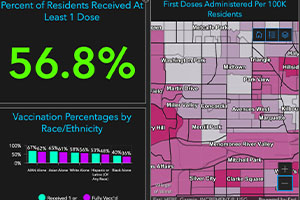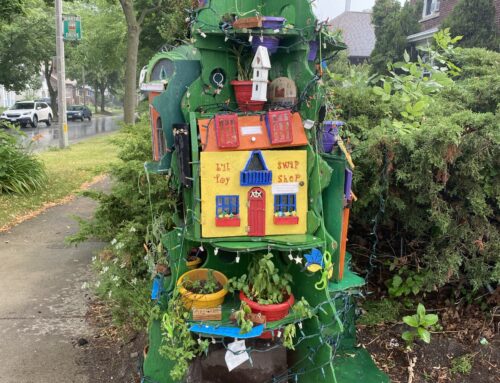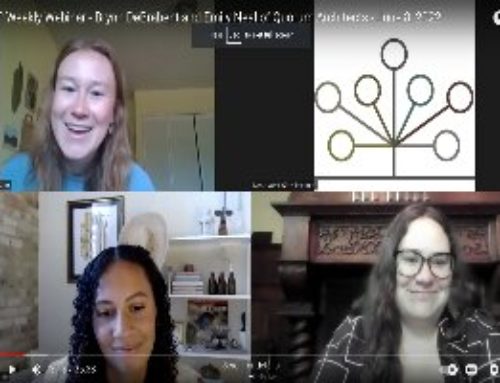By Lucas Johnson, NWSP Intern
The ongoing Covid-19 pandemic has exposed longstanding health disparities across the United states. Data has shown that across the country African-Americans and other minorities are dying at a higher rate than White Americans, even though African-Americans make up a far less percentage of the population. Traditionally minorities are more likely to live in crowded conditions, work service jobs that put them at risk of exposure, and are more likely to have pre-existing health conditions that increase the risk of Covid-19. Near West Side Partners is committed to improving the quality of life for all of our residents, and this includes the minority population that often checks off all of the boxes mentioned above. One important way NWSP accomplishes this goal is its effort to improve the vaccination rates across our community, so that the NEar west Side is truly a safe place to live, work, and play for all.
Data from the Milwaukee County Covid-19 Dashboard reveals that over half of Milwaukee County residents have received their first dose of a Covid-19 Vaccination, this exact number is 56.6%. Unfortunately most neighborhoods in the Near West Side fall short of this county wide average. The percentages of each Near West Side neighborhood are as follows:
First Dose Vaccination Percentages by Neighborhood per 100k Residents
Concordia >40,092 – 49,407 ≈ 40% – 49%
Cold Springs Park >40,092 – 49, 407 ≈ 40% – 49%
Avenues West >40,092 – 49,407 ≈ 40% – 49%
Avenues West by Marquette >59,423 – 71,104 ≈ 59% – 71%
Martin Drive East >40,092 – 49,407 ≈ 40% – 49%
Martin Drive West > 49,407 – 59,423 ≈ 49% – 59%
Merrill Park East 29,597 – 40,092 ≈ 29% – 40%
Merrill Park West >49,407 – 59,423 ≈ 49% – 59%
Piggsville East >49, 407 – 59,423 ≈ 49% – 59%
Piggsville West >59,423 – 71,104 ≈ 59% – 71%
Miller valley East >40,092 – 49,407 ≈ 40% – 49%
Miller Valley West > 49,407 – 59,423 ≈ 49% – 59%
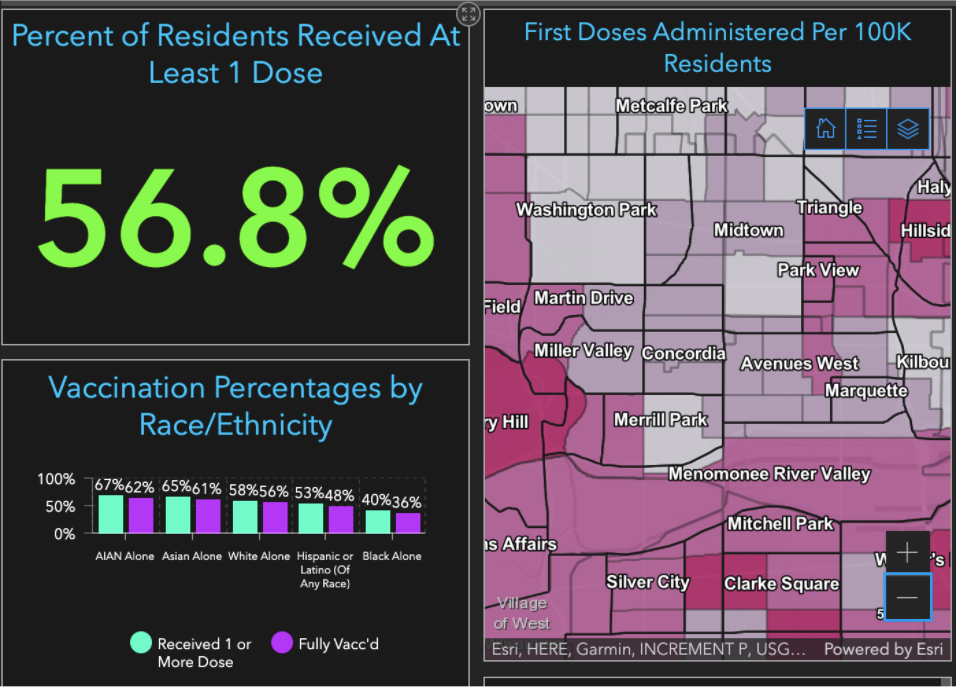
The data and graph above, provided by the Milwaukee County Covid-19 Surveillance Dashboard, brings several interesting points to light. Chief among those being that the Neighborhoods of the Near West Side are more often than not vaccinated at a lower rate than the neighborhoods surrounding them, save for the neighborhoods to the north which share similar demographics with the Near West Side. Another interesting point is the varying vaccination rates in individual neighborhoods. Of particular note is the variation in the Avenues West Neighborhood, home to residential areas, Advocate Aurora Health, and Marquette University.
Avenues West is a unique example in the Near West Side due to its combination of families nad college students, with the neighborhood being full of rental properties for Marquette University students. These rental properties also happen to fall within the boundary of Avenues West that has a higher vaccination rate. One such explanation for this variation could be due to the high number of Marquette students in the area of Avenues West closer to Marquette’s campus. On June 7, 2021 Marquette University’s President Dr. Michael R. Lovell sent out a letter to all Marquette students, requiring them to be fully vaccinated by the start of the 2021-2022 academic school year, barring medical and religious reasons. To read the letter sent out by Dr. Lovell click the link here.
So far the vaccine requirement at Marquette seems to have had nothing but positive effects on the Covid-19 rates on campus. According to Marquette’s Covid-19 dashboard, which you can find here, 94% of students have been vaccinated, along with 93% of faculty and staff. In the last six months since the vaccine mandate has come out there have been a total of 341. Per the Marquette Covid-19 Dashboard, “cases are reported to Marquette through Milwaukee, or other health department, the Marquette Medical Clinic testing facility, and the university voluntary disclosure form.” In the same time there have been 172 positive covid-19 tests conducted at the university’s on campus testing facility, out of 7,500 total tests, yielding a result of 7,328 negative tests. That would give a positivity rate of roughly 0.02%, in comparison The New York Times has reported that Milwaukee county’s positivity rate in that same time frame has hovered around the 10% mark. Though Marquette University may be a small sample size in comparison to the City of Milwaukee, or even the Near West Side; the University’s ability to mitigate the spread of Covid-19 shows how effective the vaccine is when a large portion of a population is vaccinated.
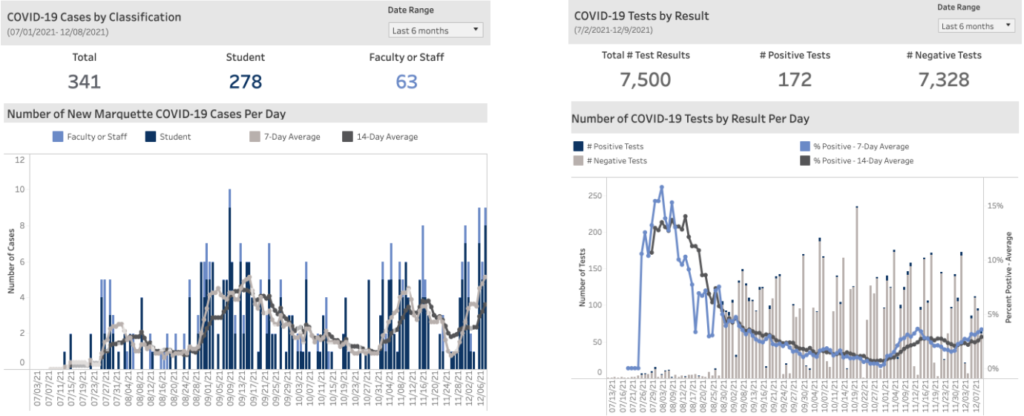
Pictured above: Data on confirmed Covid-19 cases and test results, provided by Marquette’s Covid-19 Dashboard.
To gain more insight into Marquette’s ongoing battle against the virus I took some time to chat with Dr. Abiola Keller, Assistant Director at Marquette’s College of Nursing and Chair of NWSP’s Healthy Working Team. Dr. Keller started off by telling me that Marquette’s priority was always to ensure a safe learning atmosphere for all of its students. When the pandemic first struck in March of 2020, the University made the decision to send students home and finish the school year virtually. When it was not deemed safe to return to a traditional in-person learning experience, Marquette decided to continue virtual learning until vaccines were available. With the introduction of the vaccine across the country, and its available access to most communities, Marquette decided that a vaccine requirement would be the best option to help bring back the full learning experience on a college campus, with students safely engaging with their professors and peers.
Marquette was not the only University that chose to take this vaccine requirement route, and Dr. Keller told me that Marquette faced the same dilemmas that other universities were facing. On one hand, the university wanted to make learning a comfortable experience for everyone, including those who might be more at risk of the virus. On the other hand the university did not want to seem like it was taking the liberties away from individuals who were not comfortable taking the vaccine. Finding a middle ground those who were exempted from the vaccine due to medical or religious reasons, or personal convictions are frequently tested for the virus. Dr. Keller believes that the high vaccination rates, partnered with social distancing and mask requirements have made Marquette’s campus a safe learning environment, even with the emergence of variants such as the Omicron variant.
In the wake of the Covid-19 pandemic and the emergence of vaccines to fight the virus, the Wisconsin Health Department has worked to establish various vaccination sites across the city. One such sight is located near the Near West Side community at Progressiive community Health Centers. Located at 35th and Lisbon, Progressive’s flagship center is a Multispecialty health center that serves patients from all sorts of incomes and backgrounds across the city. In the wake of the pandemic Progressive, like so many other organizations, was forced to adapt to this new world, whether it was conducting appointments virtually or all together suspending some of their features such as dental visits. However Dr. Ellison Kos, the Chief Medical Officer at Progressive, admits that the most unusual change was Progressive, “being called into the public health realm”. Dr. Kos explained that, “suddenly we were on many many meetings city-wide and regionally saying ‘How can progressive become an access point for testing? How can we then start vaccinating?”. Dr. Kos believed that the pandemic provided Progressive with an opportunity to serve the community that it cares for in a broader sense, instead of just those who are patients at Progressive. To fulfill this, Progressive set up, and still operates, a drive-thru covid testing site at their flagship location that is available to the public. They also are able to provide both Pfizer and Moderna vaccines and booster shots to the public, and through support from the Wisconsin Health Department, are able to vaccinate children.
To learn more about Progressive Health Centers and what they do click the link here.
To view the resources about the vaccine that Dr. Kos recommends clicking the links here and here.
Dr. Koss and I also spoke at length about the public perception of the vaccine, and the rates at which the city of Milwaukee is getting vaccinated. Because 82% of Progressive’s patients are African-American and come from the surrounding zip codes, they are well aware of the health disparities that the pandemic has brought to light. Dr. Kos was keen to highlight the effectiveness of the vaccine, but that effectiveness is best suited when a high percentage of a population is vaccinated. Dr. Kos admitted that she was receiving mixed perceptions towards the vaccine, some are more than willing to receive the vaccine, especially those who are more at risk. Others however are hesitant due to personal beliefs and the spreading of myths and misinformation about the vaccines. This misinformation has led to lower rates of vaccinations among younger demographics, particularly 20 to 30 year olds. In response, Progressive has done its fair share of trying to counter this misinformation with accurate data, and studies on these vaccines conducted by health professionals, adamant that the only way to convince those that are reluctant to get a vaccine is to feed them accurate information.
In part of its commitment to create and sustain a healthy community, NWSP has looked to provide the correct messaging to the public throughout the pandemic. Serving a community that is already more at-risk to health complications, NWSP understands the importance of a vaccinated community. Partnering with local organizations such as the Wisconsin Health Department and community leaders, NWSP has spent the last year creating and running a multi-media campaign to bring information to the public, whether it be on social distancing and the importance of masks, or information on Covid-testing and the vaccine. This campaign has included Webinars, Youtube videos, blogs like this, informational flyers, and signage.
Click the following links below to view videos of Near West Side residents sharing why they chose to get vaccinated.
Pictured below are a few examples of signage that has been placed in businesses around the Near West Side.
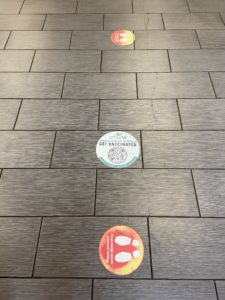
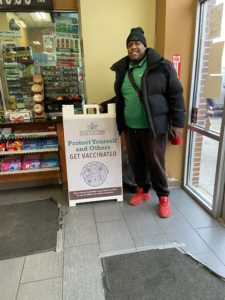
With the coming of a new year on the horizon, NWSP is as committed as ever to working with the community to ensure that the health of the Near West Side does not waver.

